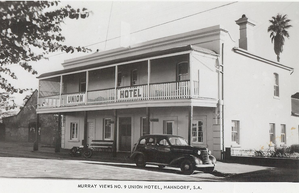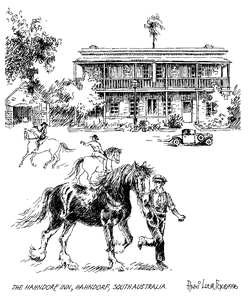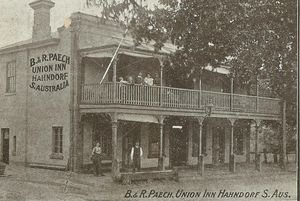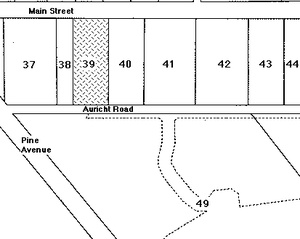LOCATION: 35 Main Street, Hahndorf
SHR 13135 – confirmed as a State Heritage Place 20 November 1986
Originally established across the road as the Australian Arms in 1854, it was transferred to a building on this site in 1863 and renamed the Union Hotel. Next door was a blacksmith shop with adjacent home. Stables for draught horses and a smokehouse were at the rear.
This hotel commenced trading in 1863 as the Union Hotel taking over the licence of the Australian Arms located across the road. It has been known as the Hahndorf Inn since 1972. It was originally a single storey building with a second floor added in the 1880s. Like the German Arms, it became a venue for public gatherings before the Institute was built in 1893.
The bottle shop alongside the hotel was once a blacksmith shop. Carl Borchers, blacksmith, conducted a thriving business here for many years which could no doubt take advantage of the hotel trade. J. Christian Jaensch Jnr. established one of Hahndorf’s first butcher’s shops on these premises where he lived and operated the family business for many years. The butcher’s shop was located in a room at the northern end of the building.
The stables for draught horses and smoke house for curing meat were situated in the small building set back from the road, adjacent to the bottle shop.
Refer to Australian Arms Hotel for earlier history of the hotel when it was originally located on the opposite side of the Main Road.
Brief History
Extract from 'Hahndorf - A Journey through the Village and its History', by Anni Luur Fox (2002)
Like its rival, the German Arms, this hotel was first established across the road from its present site. ..... Wishing to transfer his hotel to a single storey building over the road at No. 35, in December 1863, Mr Schuetze sold No. 46 to Friedrich Wilhelm Bremer. .....
 Union HotelThree years after Mr. Schuetze transferred his business over the road and changed its name to the Union Hotel, he and his family moved to Blumberg (changed to Birdwood in 1917). A second storey was added to the hotel when the district’s population swelled in the 1880’s with another surge of goldmining activity and the influx of tradespeople servicing the rural industries. Several hundred navvies working on the railway line to Mount Barker added to the boom in business at the hotel, but local residents were not amused by fights on payday nor the ladies of the night advertizing sexual services in Main Street. They lived rough with the navvies in their tent camps and in hollow logs. The law courts were kept busy while the railway was completed and the men moved on to the next construction site.
Union HotelThree years after Mr. Schuetze transferred his business over the road and changed its name to the Union Hotel, he and his family moved to Blumberg (changed to Birdwood in 1917). A second storey was added to the hotel when the district’s population swelled in the 1880’s with another surge of goldmining activity and the influx of tradespeople servicing the rural industries. Several hundred navvies working on the railway line to Mount Barker added to the boom in business at the hotel, but local residents were not amused by fights on payday nor the ladies of the night advertizing sexual services in Main Street. They lived rough with the navvies in their tent camps and in hollow logs. The law courts were kept busy while the railway was completed and the men moved on to the next construction site.
Carl Borchers, another devotee of Hahndorf Rifle Club, built his blacksmith shop and house on the southern side of the hotel in 1870. He shoed horses and made and repaired farm implements. His son Albrecht (usually called Alb) was trained by Carl as a blacksmith but found the life of a publican more suited to his character. When Thomas Ide relinqished his post of twenty-five years, Carl became publican from 1898 –1900. The balcony was added to the building by Thomas Delaney in 1901.
Situated on the main road to the eastern states, Hahndorf was assured of a steady stream of travellers, the most famous being Queen Victoria’s second son, H.R.H. Prince Alfred, Duke of Edinburgh in 1867. All the villagers turned up to the reception outside the Union Hotel where speeches were made amidst great cheering and schoolchildren sang “O Noble Prince of German Blood…” composed especially for the occasion. The prince drove his “four-in-hand” horse team back to Adelaide through Hahndorf’s main street gaily decorated with triumphal arches, flags and flowers.
 The Union Hotel continued to be the scene of rollicking weddings, parties and musical evenings. Plays and lectures ranging from “Ancient Teutonic History” to “How to make a home happy” added to the intellectual life of the community in convivial surroundings. The long list of publicans included the names Jose, Schunke, Greenfield, Bremer, Ide and Bernhard Paech, my mother-in-law’s uncle whose hospitality she enjoyed during school holidays so long ago. Seventy years of liberal drinking hours came to a halt on 27 March 1915 when the S.A. Temperance Alliance and the Six O’Clock League achieved their aim of a referendum aiming to cut hotel closing hours from 11 pm to 6 pm. 115,000 people voted in favour of the cut. The resulting “six o’clock swill” jammed bars across the state with drinkers desperate for one last beer before the doors closed. The front bar was a “males only” domain. Don Dunstan ended this state of affairs in 1967.
The Union Hotel continued to be the scene of rollicking weddings, parties and musical evenings. Plays and lectures ranging from “Ancient Teutonic History” to “How to make a home happy” added to the intellectual life of the community in convivial surroundings. The long list of publicans included the names Jose, Schunke, Greenfield, Bremer, Ide and Bernhard Paech, my mother-in-law’s uncle whose hospitality she enjoyed during school holidays so long ago. Seventy years of liberal drinking hours came to a halt on 27 March 1915 when the S.A. Temperance Alliance and the Six O’Clock League achieved their aim of a referendum aiming to cut hotel closing hours from 11 pm to 6 pm. 115,000 people voted in favour of the cut. The resulting “six o’clock swill” jammed bars across the state with drinkers desperate for one last beer before the doors closed. The front bar was a “males only” domain. Don Dunstan ended this state of affairs in 1967.
The hotel’s assembly room had become Hahndorf’s roller skating rink when that fad hit the village in the 1880’s. According to Walter Wotzke it was revived in the 1930’s. The Thiele boys who lived next to the Wittwer’s Mill, were the first to roller skate up and down main street terrorising pedestrians. Walter often spoke of the sheer fun of bumping into one another and doing spectacular falls in front of wide-eyed spectators. Vic Thiele became proficient enough to be allowed to skate on the “professional” floor at the “Our Boys Institute” in Adelaide, a step up from the cramped quarters at the Union Hotel.
In 1972, the hotel acquired a new name, “The Hahndorf Inn” when the owners began major renovations. A motel was later built over the creek. The original Australian Arms building over the road became a leatherworker’s place of business and Borchers backsmith shop became a bottleshop. In 1999 the Duffield family refurbished the hotel to encourage patronage by families, a far cry from the days of the six o’clock swill. At the time of writing, the Hahndorf Inn is one of few hotels in South Australia that is free of poker machines.
Early Ownership
Information from The Hahndorf Allotments Database compiled by Reg Butler.
| Old Lot No. | New Lot No. | Street No. | Street Name |
| House 23 | S.H. 39 | 35 | Main Street |
| Year Sold | New Owner | Occupation | Owner's Home | Personal |
| 1849 | Joseph Remfrey | mining captain | Kanmantoo | Land grant. |
| 1853 | Gottlieb Schütze | carpenter | Hahndorf | GRO title. |
| 1855 | James Owen | licensed victualler | Kensington | LTO title c 1863. |
| 1864 | Ludwig Stark | blacksmith | Hahndorf | |
| 1873 | Christian Klaebsch | mason & blacksmith | Hahndorf | |
| 1876 | Carl Borchers | blacksmith | Hahndorf | |
| 1901 | August Haebich | blacksmith | Hahndorf | |
| 1920 | Hermann Paech | farmer | Hahndorf | Brother-in-law of A Haebich. |
| 1939 | Bertha Paech | widow of H Paech | Hahndorf | Nee Jaeschke. |
| 1950a | Selma Liebelt | nee Paech | Mt Barker | Wife of Edmund Liebelt, farmer. |
| 1950b | Edmund Paech | farmer | Hahndorf | Cousin of S Liebelt. |
| 1973 | Paechtown Holdings Pty Ltd | business firm | Pirie St, Adelaide | |
| 1975 |
Hersey Holdings Pty Ltd and Tomkinson Rowe Finance Pty Ltd |
business firm business firm |
Adelaide Adelaide |
Notes:
- The rear of this allotment is now a Motel, in conjunction with SH 38.
- 4067/980 Metric title.
Early Hahndorf Inn Publicans
Compiled by Reg Butler
- 1854-1855 SCHÜTZE, Gottlieb Andreas
- 1855-1856 OWEN, James
- 1857-1865 SCHÜTZE, Gottlieb Andreas
- 1856-1857 ANDERSON, William
- 1865-1869 JOSE, Arthur
- 1869-1870 SCHUNKE, George
- 1870-1871 GREENFIELD, M
- 1871-1872 BREMER, FW
- 1872-1897 IDE, Thomas
- 1898-1900 BORCHERS, Albrecht W
- 1901-1908 DELANEY, Thomas
- 1909 PAECH, Bernhard & Richard
- 1910-1921 PAECH, Bernhard
- 1922-1923 STEVENS, Mrs LA
- 1924-1927 STEZELBERG, REM
- 1927-1928 LAMBERT, AE
-
1928-1954 WALLACE, James Bertram




